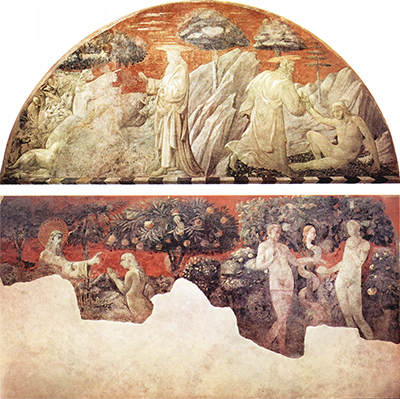The fresco The Creation of the Animals and Creation of Adam is categorised as an early work of Paolo Uccello. It shows the influence of his time as an apprentice with the artist Ghiberti, whose workshop he joined as a young boy.
Uccello's fresco is one of his creation scenes in the Chiostro Verde of the Santa Maria Novella in Florence. Part of the sequence is believed to have been produced between 1430 and 1436, while the remainder was completed some ten years later. The Chiostro Verde, or Green Cloister, is named from the use of "terra verde”, the greenish pigment derived from iron silicate and clay. This famous Renaissance colour thus provides the setting for art which combines elements of both Uccello's geometric approach and Ghiberti's Gothic style.
Ghiberti’s Paradise Door in the Baptistery, Florence is clearly the major influence on Uccello's fresco. In Ghiberti's sculpted version, God is seen at the lower left of the door, bringing Adam to life as he reaches down to him in a way that immediately reminds the observer of Michelangelo’s Sistine Chapel masterpiece. As in the Sistine Chapel, Adam’s uplifted hand seeks to complete the connection as though he still needs divine sustenance in order to rise to his feet.
The similarity is no coincidence. The theme flows from Ghiberti, through Uccello, to Michelangelo. Uccello’s version shows a reverse image of Ghiberti’s door, with a robed deity, who is very human in appearance, reaching down to a bewildered naked Adam. The effect is of a god who is cosmic gardener or husbandman, at home in the Garden of Eden caring for his creation. The figure of Adam is influenced by the work of Masaccio, whose muscular image of Adam in turn inspired Michelangelo's great work.
The other part of creation, the animal kingdom, appears on the left hand side of the scene. Although this fresco is badly damaged, it is clear that the animals stand before God with an instinctive awareness of his nature. He is their creator too, although the relationship is clearly different. This part of the fresco reflects Uccello's own joy in painting animals and nature. He particularly loved birds, earning him the nickname "Paul of the Birds", and his beautiful, natural frescoes were well-received.




